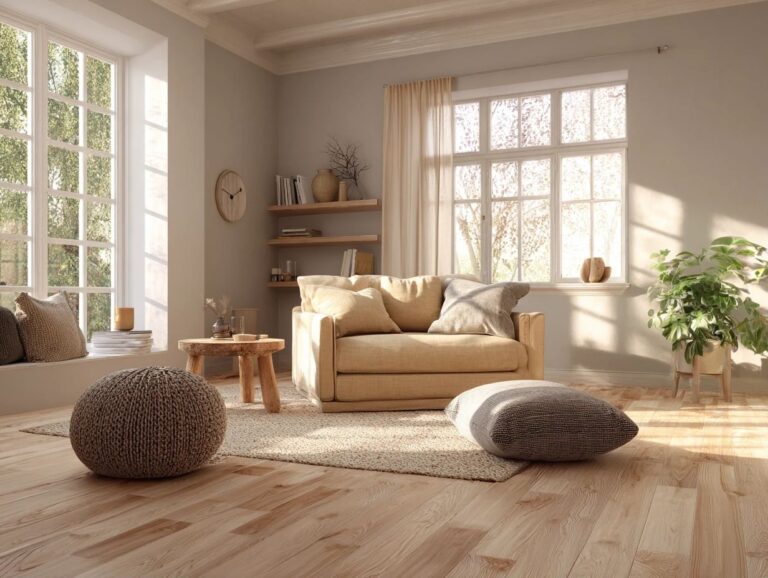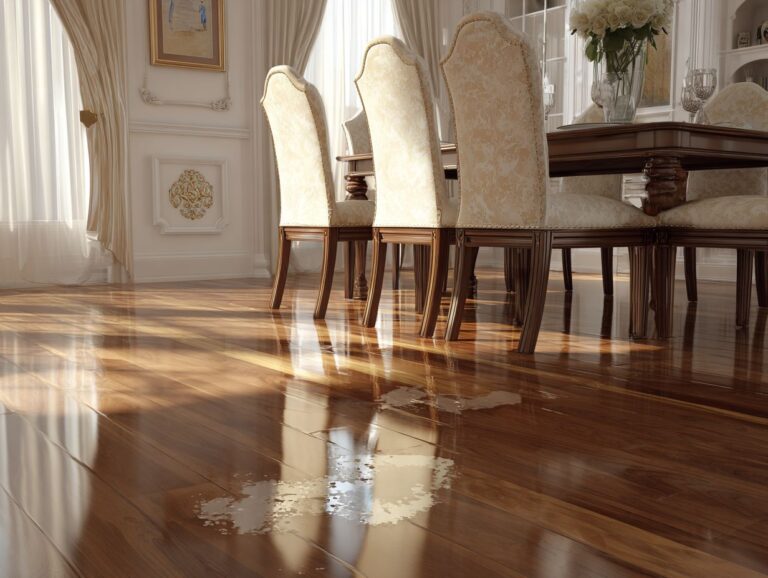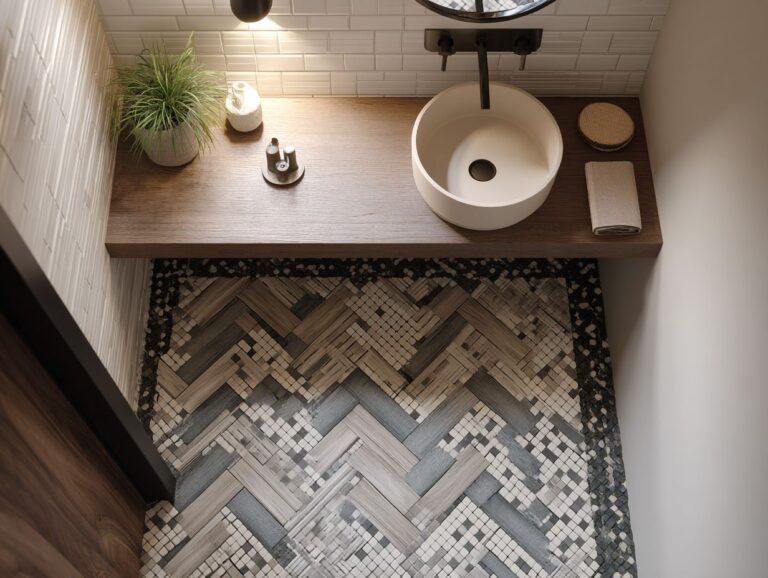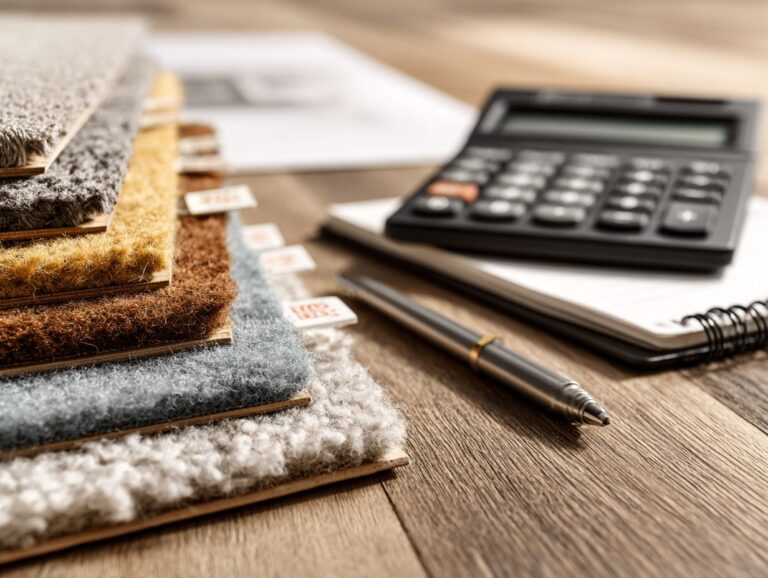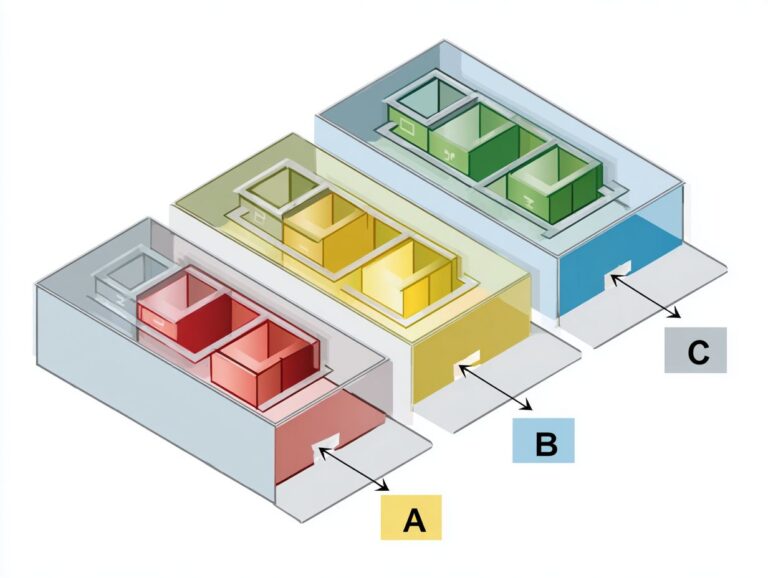Luxury Flooring – When Premium Materials Make Sense
Contents
Introduction to Luxury Flooring

Key Takeaways:
Definition of Luxury Flooring
Luxury flooring is defined as flooring made from premium materials that provide both high durability and aesthetic value, distinguishing it from standard options.
Key features of luxury flooring include high-quality materials like solid hardwood, natural stone, or premium vinyl, which provide lasting durability and performance.
Design flexibility is another hallmark; luxury brands like Havwoods and Moso offer various finishes, colors, and textures that cater to diverse interior styles.
These flooring choices can improve the appearance of areas, giving them a more prestigious look. Picking this type of flooring enhances the appearance of your home and increases its price, making it a wise choice for homeowners focused on their property’s value.
Luxury Flooring and Resilient Flooring Market Analysis
Luxury Flooring and Resilient Flooring Market Analysis
For homeowners looking to make improvements, flooring upgrades can be a significant investment. Our expert opinion highlights how these upgrades impact your home’s market value. Discover insights from realtors on how flooring choices can influence home sale prices in our detailed analysis: Flooring Impact on Home Sale Price – Realtor Insights.
Market Growth and Trends: CAGR Projections
The Luxury Flooring and Resilient Flooring Market Analysis offers clear predictions on the expansion of these flooring industries in the next few years. The data highlights the expected growth rates and shows how the market is developing, presenting possible chances for those involved in the flooring industry.
Market Growth and Trends highlight the Compound Annual Growth Rate (CAGR) projections for two distinct segments: the luxury flooring market and the U.S. resilient flooring market. The luxury flooring market is anticipated to see a strong compound annual growth rate of 14.4% from 2025 to 2032. This significant growth can be attributed to increasing demand for high-quality, aesthetically pleasing flooring options in residential and commercial spaces. As consumers prioritize style and durability, luxury flooring materials, such as natural hardwoods and premium vinyl, are becoming more popular. Progress in flooring technology and design is expected to help grow this market.
In contrast, the U.S. resilient flooring market is projected to grow at a more modest CAGR of 4.3% from 2024 to 2032. Resilient flooring, which includes materials such as vinyl, linoleum, and rubber, is valued for its durability, versatility, and cost-effectiveness. The steady growth rate reflects a consistent demand for affordable flooring solutions that offer both functionality and style. The increasing trend towards sustainable and eco-friendly building materials is also anticipated to contribute to this market’s development, as many resilient flooring options are manufactured with recycled or renewable materials.
The market study indicates that luxury and strong flooring areas are likely to grow, though they will expand at different rates. As the luxury flooring market capitalizes on consumer preferences for premium aesthetics, the resilient flooring market will continue to cater to the need for practical, sustainable solutions in various settings. People in the flooring industry can use this information to adjust their strategies and investments to match changing market trends.
Importance of Material Quality
The quality of materials directly influences the longevity, maintenance, and overall appearance of luxury flooring solutions.
Materials like wide-plank oak and natural stone improve the look and offer great durability. Brands such as Muletto provide wide-plank oak flooring that can last for decades, requiring minimal upkeep.
Natural stone options from companies like MSI deliver stunning textures and colors, enhancing the appeal of high-end residential projects. Using these high-quality materials guarantees a durable finish that lasts, perfect for homeowners who want to create a luxurious environment. Worth exploring: Flooring ROI by Material – Which Adds Most Value.
Types of Luxury Flooring Materials
Quality flooring materials come in various types, each offering unique benefits and a fashionable appearance for sophisticated designs. To understand the impact of these choices, see how flooring can influence home sale price, backed by realtor insights and statistical references.
Hardwood Flooring
Hardwood flooring, including engineered options and reclaimed timber, is celebrated for its timeless beauty and versatility in high-end interiors.
Hardwood flooring comes in different designs, improving appearance and use. Popular choices include:
- Herringbone patterns, which add a sophisticated touch,
- Wide plank designs that create a sense of space.
Brands like Floor Warehouse offer an extensive selection, featuring high-quality engineered wood suitable for moisture-prone areas. For maintenance, consider using Bona Wood Floor Cleaner to preserve the finish and minimize scratches.
Using high-quality materials increases property value and keeps your home looking stylish for years.
Marble and Stone Flooring
Marble and natural stone floors offer a high-end look, combining long-lasting strength with a distinctive appearance, including choices like large tiles.
These materials improve the look and reduce noise and echo in larger spaces.
For instance, installations in luxury penthouses often feature large slabs of white marble, which create a spacious feel while absorbing sound. The use of textured stone in common areas blends seamlessly with biophilic design principles, promoting a connection to nature.
Choosing honed or polished surfaces can affect the acoustics in your home to match your taste, creating a calm and fashionable space.
Luxury Vinyl Plank (LVP)

Luxury Vinyl Plank (LVP) flooring offers modern features and appealing looks, making it a popular option for homeowners who want both elegance and functionality.
LVP is generally much cheaper than traditional hardwood, costing about 30-50% less. Its ease of maintenance is another highlight; a simple sweep and occasional mopping suffice to keep it looking new.
Modern designs replicate the appearance of wood, stone, or tile beautifully, enhancing any decor. Innovative features like waterproofing allow it to withstand moisture-prone areas like kitchens and bathrooms.
Look for eco-friendly options made from recycled materials to further support sustainable living. With a vast array of styles available, LVP caters to diverse tastes and budgets.
Carpet Tiles and Plush Carpets
Carpet tiles and plush carpets offer warmth and comfort, contributing to the luxury feel of a space while also providing practical benefits like acoustic reduction.
Using carpets in luxury spaces provides great design options. They can be arranged in patterns or used to create zones within larger spaces.
For installation, you might choose adhesive tiles for quick setup or underlay systems for extra padding and noise reduction.
To maintain their allure, vacuum regularly and use a professional cleaning service annually. These practices help the carpet last longer and keep its rich textures and bright colors, representing luxury.
Benefits of Choosing Premium Materials
Choosing high-quality flooring materials improves the look of a room and offers lasting benefits.
Durability and Longevity
Luxury flooring materials are designed to withstand wear, often lasting decades with proper care, which justifies their higher initial price points.
Engineered hardwood is made with real wood layers on top of a plywood base, which makes it less likely to warp and better at handling moisture compared to regular solid hardwood.
While solid hardwood can shift with humidity changes, engineered options maintain their shape better.
For upkeep, you just need to sweep regularly and occasionally mop with a mild cleaner for both types. Engineered wood usually needs refinishing less often than solid hardwood.
This durability means engineered flooring can be a practical choice for busy households looking to marry aesthetics with longevity.
Aesthetic Appeal and Design Flexibility
The beautiful look of luxury flooring lets homeowners show their personal taste through different styles and finishes.
Reclaimed wood provides a rustic feel that improves classic interiors, and its distinctive grain patterns can also match modern spaces.
For instance, pairing wide plank reclaimed oak with minimalist furniture can create a modern yet warm ambiance.
On the other hand, cork flooring is an eco-friendly option that works well in both artistic and casual settings. Its natural texture adds comfort underfoot-perfect for home offices or playrooms.
Combining visuals of these materials in mood boards can further inspire creative design solutions.
Increased Property Value
Investing in luxury flooring can significantly increase property value, appealing to potential buyers who prioritize high-end finishes.
A study by the National Association of Realtors found that homes with premium flooring can sell for up to 10% more than those with standard options.
For example, hardwood floors made from oak or walnut improve the look and last longer, attracting buyers who are particular.
Using materials like porcelain tiles can also attract attention, especially when showcasing designs that mimic natural stones.
By showing these high-quality finishes in listings, sellers can draw in buyers interested in elegance and long-lasting materials.
When to Invest in Luxury Flooring
Choosing the right time to invest in high-quality flooring can increase your profits and improve the look of your home.
High-Traffic Areas
In high-traffic areas, the durability and resilience of luxury flooring materials become paramount to maintain aesthetics and functionality.
For such spaces, consider luxury vinyl plank (LVP) and cork flooring. LVP is waterproof, easy to clean, and resembles hardwood, making it ideal for high-traffic areas.
Cork, while softer, offers incredible natural shock absorption and can reduce noise. To preserve their condition, regularly clean both types with a damp mop and avoid harsh chemicals.
To keep cork safe, put on more sealant every few years. These steps will help keep your flooring looking good and working well for a long time.
Luxury Homes and Custom Builds

Luxury homes and custom-built houses often require flooring that fits the owner’s preferences and enhances the property’s design.
Working with famous designers such as Kelly Wearstler and Camilla Hampton is important when choosing floors for high-end homes. Consider factors such as material, texture, and color.
For instance, natural stone or hardwood can exude elegance, while artisanal tiles offer a unique touch. Make sure the flooring matches the home’s style-such as choosing smooth finishes for modern designs or using distressed wood for traditional homes.
Engaging with a designer can help align your flooring choice with the overall aesthetic vision, creating a cohesive luxury experience.
Renovation Projects
Renovation projects are a great chance to improve a room by adding high-end flooring, changing both its look and how it is used.
Selecting quality luxury flooring can significantly improve your renovation. Consider materials like hardwood, which adds warmth and elegance, or natural stone, which brings sophistication.
To create a unified appearance, choose flooring that matches the current style of the building. For example, wide-plank oak works well with classic homes, while smooth porcelain tiles fit modern designs.
Use samples to see how the flooring looks in your area and consider how much care it will need. Investing in quality underlayment can also improve comfort and durability, ensuring your luxurious choice stands the test of time.
Cost Considerations
Knowing the expenses involved with high-end flooring is important for homeowners planning their budgets for improvements or remodels.
Initial Investment vs. Long-Term Savings
While the initial investment for luxury flooring may be higher, the long-term savings in maintenance and replacement costs can prove beneficial.
For instance, high-end vinyl planks require minimal upkeep and resist moisture, reducing the need for frequent replacements typical of cheaper options.
Consider that hardwood flooring can last over 30 years with proper care, whereas laminate may need replacement in just 10-15 years.
High-quality materials frequently include warranties lasting as long as 50 years, ensuring security.
By calculating your spending over a 20-year period, you may find that investing in quality flooring can lead to substantial savings in both product costs and maintenance efforts.
Maintenance Costs of Luxury Flooring
High-end flooring needs proper care routines, which can affect the total cost of ownership but help it last longer and look better.
Different types of luxury flooring-such as hardwood, laminate, and natural stone-each have unique maintenance needs.
Hardwood flooring, for example, benefits from periodic refinishing and should be cleaned with a pH-balanced cleaner. In contrast, laminate is easier to maintain, needing only regular sweeping and occasional damp mopping.
Natural stone is attractive but must be sealed every few years to prevent stains and should be cleaned gently.
Setting up a regular cleaning and care plan can save money over time and keep your floors looking good and lasting longer.
Environmental Impact of Luxury Flooring
Choosing flooring that is both eco-friendly and high-end is important for homeowners who care about the environment.
Sustainable Sourcing of Materials
Sustainable sourcing of materials like reclaimed wood is essential for minimizing environmental impact while enjoying luxury flooring.
Consider brands like Lumber Liquidators, which offer reclaimed wood options, or Mohawk, known for its commitment to sustainability.
Choosing flooring with FSC certification supports sustainable forestry. Bamboo is an excellent alternative; it’s fast-growing and replenishes quickly.
When selecting luxury flooring, look for companies that provide transparency in their sourcing practices and use low-VOC finishes, such as Shaw Floors. Choosing these materials helps keep things environmentally friendly and also makes your space look better.
Eco-Friendly Flooring Options
Luxury homeowners are choosing cork and bamboo flooring as these eco-friendly options are gaining popularity for being sustainable.
These materials reduce environmental harm and have impressive looks. Cork is great at keeping heat in and reducing noise, which makes it perfect for hot areas.
On the other hand, bamboo, which grows quickly in just a few years, is very strong and looks like regular hardwood. Both choices are easy to maintain, using simple cleaning solutions, unlike some luxury materials that require specialized care.
By choosing eco-friendly flooring, homeowners can improve their homes without sacrificing style or quality, helping to create a cleaner environment.
Final Thoughts on Luxury Flooring
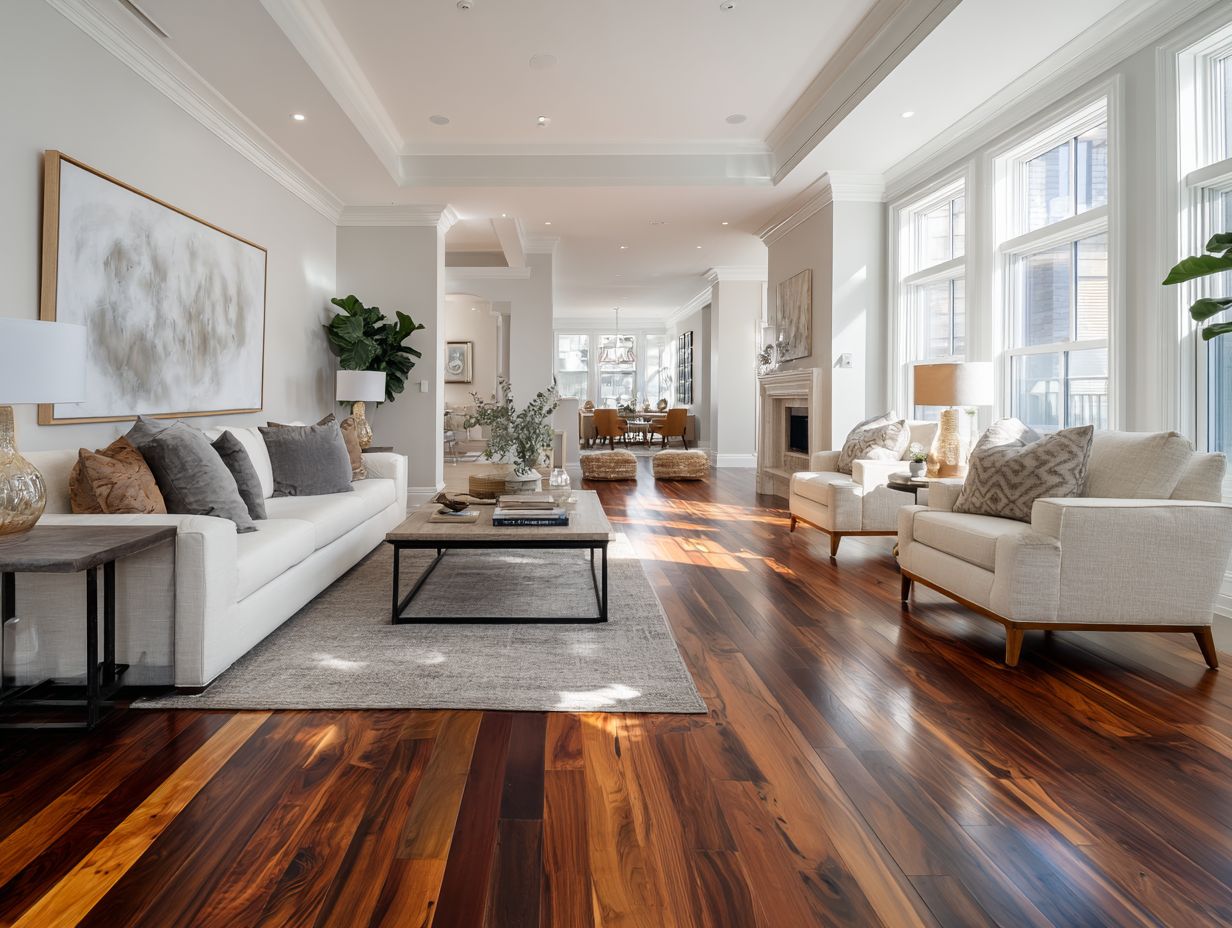
Luxury flooring is a good option for its high quality and attractive appearance, providing both elegance and functionality.
When choosing luxury flooring, consider materials like:
- Hardwood
- Porcelain tile
- Vinyl plank
Hardwood offers timeless elegance and durability. For instance, oak is popular for its rich grain and longevity.
Porcelain tile, on the other hand, mimics natural stone while providing stain and scratch resistance, ideal for high-traffic areas.
Luxury vinyl plank looks good and resists water, so it’s a good choice for kitchens and bathrooms.
Making your home both attractive and practical adds value, and is something every homeowner should think about.
Making Informed Choices
Choosing luxury flooring involves knowing about different materials, design choices, and how to care for them.
Start by evaluating your space. For high-traffic areas, consider materials like engineered hardwood for durability or luxury vinyl tiles for easy maintenance.
When exploring design, look at color trends and textures; for instance, large format tiles can make a small room feel expansive. Don’t forget about maintenance-engineered wood requires periodic refinishing, while luxury vinyl generally just needs a damp mop.
Researching local suppliers and consulting professionals can help match your preferences with practical solutions, ensuring your flooring investment meets both aesthetic and functional needs.
Frequently Asked Questions
What is luxury flooring?
Luxury flooring means high-quality flooring made from top materials like hardwood, marble, or natural stone. These materials are known for their durability, aesthetics, and overall quality.
When should I consider using luxury flooring?
You should consider using luxury flooring when you want to achieve a high-end and luxurious look for your home or commercial space. These materials are also ideal for high traffic areas, as they are more durable and long-lasting.
What are the benefits of using luxury flooring?
Luxury flooring offers better looks, lasts longer, and can raise the worth of your property. These materials are simple to maintain, making them a good choice moving forward.
What types of luxury flooring materials are available?
Some common types of luxury flooring materials include hardwood, marble, natural stone, and designer tiles. These materials come in a variety of colors, patterns, and styles, allowing for customizable and unique designs for your space.
Is luxury flooring suitable for all areas of the home?
Yes, luxury flooring is suitable for all areas of the home, including high traffic areas like entryways and kitchens. However, you should think about the upkeep needed for each kind of luxury flooring, as some materials might get damaged more easily in specific places.
Is luxury flooring worth the investment?
Yes, luxury flooring is worth the investment for those looking to achieve a high-end and luxurious aesthetic for their space. These materials improve the appearance of a home or business, increase the property’s worth, and can be durable with good upkeep.
